Introduction
Inbound freight often remains a hidden yet powerful lever within supply chain management. While many businesses focus heavily on outbound shipments and customer-facing delivery performance, inbound freight quietly accumulates significant costs that can erode margins. Inbound transportation expenses often make up a substantial part of the logistics budget, yet they frequently receive the least strategic attention.
This oversight often leaves vendors in control of shipping processes, which leads to limited visibility, inconsistent service levels, and inflated charges hidden within purchase orders and invoices. Without a structured approach to managing inbound shipments, companies face an uphill battle against inefficiencies and uncontrolled spending.
Fortunately, inbound freight does not have to be a blind spot or a drain on profitability. With the right strategy and expert guidance, organizations can take ownership of inbound logistics and unlock measurable savings. From establishing vendor compliance programs to reassessing freight terms and leveraging advanced shipping technologies, there are actionable ways to gain control and cut costs all without disrupting operations.
At Torro Freight, our transportation experts specialize in identifying these opportunities and implementing tailored solutions that help businesses reduce inbound freight costs while optimizing overall supply chain performance. This guide highlights the best practices and proven methods to help you transform inbound freight from a liability into a competitive advantage.
How to Reduce Inbound Freight Costs?
Effectively managing inbound freight costs requires a proactive and strategic approach. Simply accepting the status quo, where vendors dictate shipping methods and costs, often results in hidden expenses and a lack of control. Instead, businesses must reassess their inbound logistics strategy and take ownership where possible. Doing so not only uncovers cost-saving opportunities but also strengthens the overall supply chain.
The key lies in identifying inefficiencies and working towards better control and visibility. From renegotiating shipping terms with suppliers to introducing smart technologies, companies that approach inbound freight with purpose and structure often realize measurable savings.

Review Your Approach
Before making changes, companies should first evaluate their current inbound freight processes. How much control do you currently have over vendor shipments? Are freight terms favoring the supplier more than your organization? Reviewing existing freight agreements and shipping patterns helps reveal areas where adjustments can lead to lower costs.
Additionally, consider centralizing inbound freight management. Allowing each department or location to handle their own inbound shipments can lead to inefficiencies and missed consolidation opportunities. A unified approach enables better rate negotiation and optimized scheduling.
Enhance Visibility with Technology
Technology plays a crucial role in reducing inbound freight expenses. Without real-time visibility into shipments, businesses are left in the dark about potential delays, excessive charges, or routing inefficiencies. Implementing Transportation Management Systems (TMS) or working with freight partners that offer advanced tracking capabilities ensures complete shipment transparency.
With access to shipment data and performance metrics, companies can make informed decisions, identify problem areas, and continuously improve their logistics processes. Visibility also strengthens supplier accountability, as vendors know their performance is being monitored closely.
Enforce a Retail Compliance Program
A well-defined retail compliance program ensures vendors adhere to shipping guidelines that help control inbound costs. By setting clear requirements for packaging, labeling, delivery windows, and carrier usage, companies can minimize delays, reduce fines, and prevent costly disruptions at receiving docks.
When vendors fail to comply, it often results in accessorial charges or strained warehouse operations. Establishing penalties for non-compliance encourages suppliers to align with your freight standards, ultimately contributing to smoother and more cost-effective inbound logistics.
Summary
Reducing inbound freight costs requires a combination of strategy, technology, and supplier alignment. By reviewing your approach, enhancing shipment visibility, and enforcing retail compliance, businesses can significantly lower expenses while improving supply chain efficiency. The next step is finding a reliable logistics partner to implement and scale these improvements across your operations.
Conclusion
Inbound freight is far too important and costly to leave unmanaged. Without proper visibility, supplier accountability, and strategic control, inbound shipments can quietly drain your transportation budget and impact overall profitability. Ignoring this essential part of the supply chain often leads to hidden expenses and missed opportunities for savings.
By reassessing your current freight management approach, enhancing visibility with advanced technology, and enforcing a robust retail compliance program, your business can take meaningful steps toward reducing inbound freight costs. However, true optimization requires more than isolated efforts. Partnering with a knowledgeable and proactive logistics provider ensures every shipment is handled with cost-efficiency and performance in mind.
At Torro Freight, we specialize in helping businesses unlock hidden savings within their inbound freight operations. Our proven strategies, technology-driven solutions, and collaborative vendor management programs empower companies to cut costs, improve visibility, and strengthen supply chain performance without compromising service or reliability.
Take control of your inbound freight today. Contact Torro Freight and let our inbound freight specialists show you how to reduce logistics costs, improve shipment visibility, and create a more efficient, profitable supply chain.




